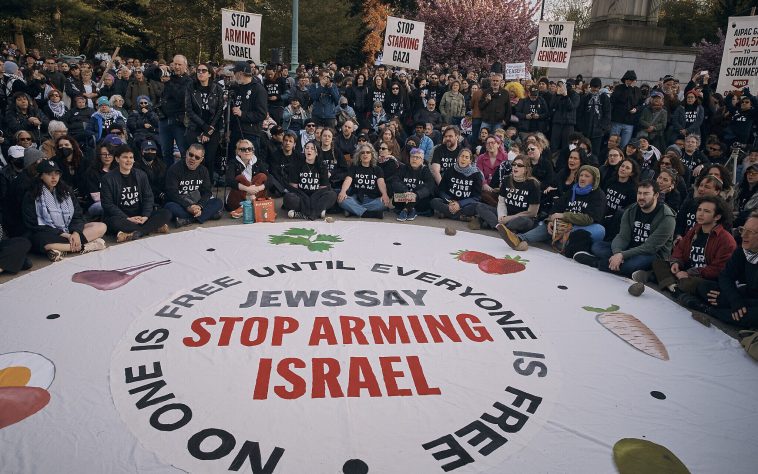A woman identified as Taylor Pelton, 28, has been apprehended by the authorities in connection to alleged vandalism acts during recent pro-Palestinian demonstrations. The police took Pelton into custody on Wednesday, with charges of hate crimes, specifically acts of criminal mischief. It is believed that Pelton is among a group of six individuals who were captured on CCTV footage defacing residences of Brooklyn Museum’s executives with red paint.
Officials of the museum are Anne Pasternak, the Director, and Kimberly Trueblood, the President and COO; both of their homes were targeted on June 12. Presently, Pelton is under court supervision after an arraignment that took place Wednesday night. The spokesperson of the Brooklyn district attorney’s office made this information public.
Pelton’s defense attorney, Moira Meltzer-Cohen, conveyed her views through an email where she voiced concerns over the labeling of Palestinian solidarity movements as hate crimes. According to the details revealed in the court documents, there are evidences suggesting that Pelton participated in the red paint vandalism of Pasternak’s and Trueblood’s homes, in association with others. They also displayed banners bearing messages such as ‘BLOOD ON YOUR HANDS’ and ‘WHITE SUPREMACIST, FUNDS GENOCIDE.’
Additional details from the court papers indicate that an inverted red triangle was spray painted on Pasternak’s front door. Authorities have considered this significant since this iconography is believed to be utilized by Hamas for signifying Israeli military objectives. The search continues for the other individuals who were visible in the surveillance recordings alongside Pelton, according to the district attorney.
The targeted act of defacement against Pasternak, who is of Jewish descent, has drawn widespread condemnation. Key figures such as Mayor Eric Adams joined others in explicitly condemning this act. According to Adams, such actions cannot be categorized as the expression of free speech or peaceful protests, instead, he dubbed them as clear manifestations of unacceptable antisemitism, which is a crime.
The timing of the vandalism raises eyebrows as it occurred shortly following a wave of pro-Palestinian protests. A sizeable number of protesters had descended upon the museum, even taking over its lobby. In this context, Meltzer-Cohen sent an email stating that tagging criticisms of Israel as hate crimes demonstrates a drastic and concerning deviation from the principles our legal and political systems are based on.
She argued that the prosecutors are acting out of character by interpreting anti-Zionist expressions as being representative of an attack on an entire religious identity, a move which she sees as troubling. Soon after, museum officials released a statement to clarify that there is a crucial difference between peaceful protesting and engaging in criminal activities.
The museum maintains that its overarching vision lies in art’s power to breed dialogue as well as cultivate understanding amongst individuals coming from a wide range of experiences and perspectives. While their statement recognized the importance of peaceful protests, they explicitly denounced behaviour that bordered on criminality.
In this charged and complex scenario, the role of law enforcement, legal representatives, and social institutions becomes vital. The case is not only about punishing those who perpetrate hate crimes, but it is also about discerning protest from criminal activity.
The larger concern becomes the potential for such incidents to deter efforts at dialogue and mutual understanding, which the museum officials emphasized in their statement. Art institutions like the Brooklyn Museum become crucial platforms for the facilitation of these dialogues.
As the legal proceedings unfold, the case serves as a stark reminder that the freedom of expression and right to protest must be safeguarded. However, these rights should not be mistaken or used as a veil for instigating actions that infringe upon the rights and safety of others.
Building on Meltzer-Cohen’s statement, it is pertinent to question whether the charges do indeed represent an ‘endorsement of rhetorical collapse of Zionist ideology and protected religious identity.’ If such is the case, this trial could potentially serve as a legal precedent that could shape future discourse on the matter.
Reports suggest a vigilant search is underway for the rest of the individuals believed to have been involved in the acts of vandalism. In response, social institutions, authorities, and the public must work together to condemn unequivocally any form of hate crime.
In summary, this instance raises questions around the limits of protest, the balance of rights, and the potential labelling of anti-state critique as hate crimes. As the story unfolds, it will no doubt influence not just how we discuss Palestine and Zionism, but also how we discuss protest and hate crimes moving forward.


